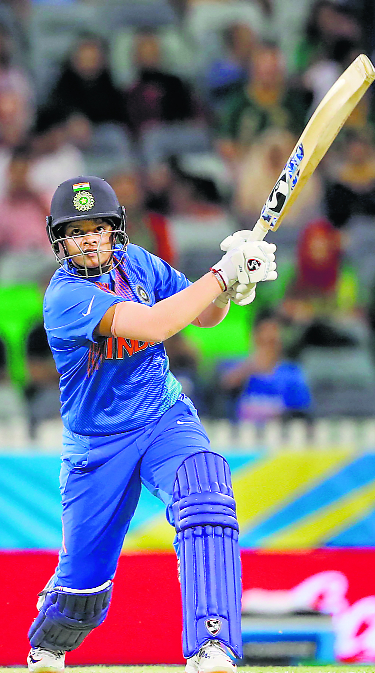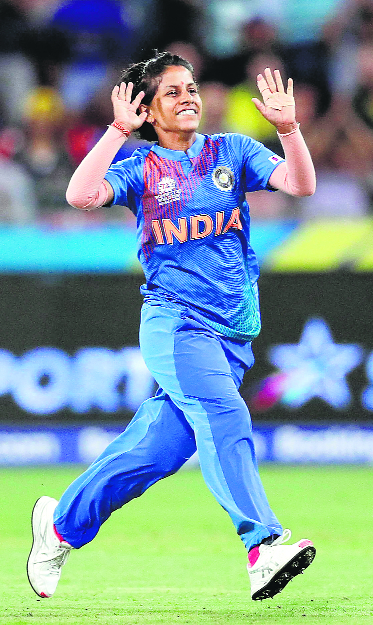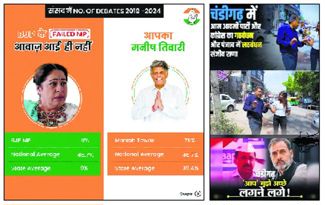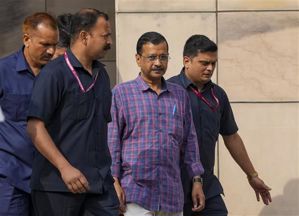
Rohit Mahajan
It’s perhaps not the most popular thing to say on Women’s Day, but it’s true that Shafali Verma bats like a man. Batting like men is not necessarily a disgrace, especially if they happen to be Virender Sehwag or Sachin Tendulkar. Even brainy and serious-minded experts such as Nasser Hussain say Shafali bats the way Virender Sehwag did. She has similar methods — she plants her left foot forward and hits the ball hard. See the ball, hit the ball — the Sehwagian method. It works.
Shafali Verma @ World cup
1 She has jumped to the top of the T20I batting charts. She’s the second Indian batswoman after Mithali Raj to achieve this feat
161 Her strike rate in four matches. The blistering starts went a long way in India winning all their league games
9 Number of sixes she has smashed so far. It’s primarily her six-hitting prowess that makes her stand out
Not too many women players hit it as hard as this teenager who made coaches at Shri Ram Narain Cricket Club in Rohtak sit up in amazement when she started batting.

There’s a buzz around the Indian women’s team, and the biggest buzz is around Shafali, for it’s she who has dragged India to the final of the women’s T20 World Cup, with help from the spinners. Shafali has made 29, 39, 46 and 47 runs in India’s wins; that’s 161 runs off 100 balls for a strike rate of 161. India’s Powerplay run-rate is 8.25, the highest in the World Cup. It’s entirely due to her. She’s hit 9 sixers, the most by anyone in the event. In 18 T20Is overall, since making her debut less than six months ago, Shafali has struck 21 sixers. Experts and players are unanimous in their view that the final on today is likely to be decided by how long Shafali would bat — not how she bats, because there’s only one method she knows: Fearless attack.
No lover of women
India has been a reluctant supporter of women. In 2005, the International Women’s Cricket Council merged with the International Cricket Council (ICC), which governed men’s cricket. ICC instructed its member boards to similarly govern women’s cricket too; the Indian cricket board (BCCI) did not want to do it. The merger made sense — the women could then use the excellent infrastructure available to the men. You’d imagine that supposedly cricket-loving officialdom would have loved the idea of getting everyone playing the sport. Not really. BCCI was the last of the world’s major cricket boards to take women’s sport under its wing. And the support was not absolute — tours were organised irregularly and women remained low-priority. An example: In 2013, the women’s World Cup matches were moved from Mumbai’s Wankhede Stadium so that the Ranji Trophy final could be played there.

Religion?
Cricket a religion in India? Well, for men’s national cricket it might be, but not for the Ranji Trophy players, and certainly not for the women. Shafali brings with her the possibility that women’s cricket would strike it big in India, too. It’s big in England and Australia, where the sport has been run in a very professional manner for some time. But it’s worth nothing that while women have been playing cricket for just as long as men, even in England the first professional contracts for women were handed out only in 2014. This year the number of contracted players increases from 21 to 40. Australia has taken bigger strides — the male and female players of Australia negotiated a deal that raises the pay of women players from $7.5 million to $55.2 million.
It’s not a matter of pride that the richest cricket board in the world, BCCI, was international cricket’s last Full-Member board to offer its women cricketers central contracts. In 2017, Harmanpreet Kaur’s one innings changed everything — she struck 171 off 115 balls in the 50-over World Cup semifinals and put India in the final. India suffered a heartbreaking loss in the final, but the team gained unprecedented recognition and acclaim. India now has 22 women player centrally-contracted with BCCI, annually worth Rs10 lakh yearly (11 players) Rs30 lakh (8) and Rs50 lakh (3). These numbers are good but still peanuts, often comparable to the annual travel expenses of BCCI’s officials.
Teen phenoms
The Indian team of the next decade will be powered by Smriti Mandhana and teen phenoms such as Shafali, Richa Ghosh, also 16, and Jemimah Rodrigues, who at 19 is already a senior. Clearly, young girls are picking up the sport and getting better at it. BCCI must step up, too — a good start would be giving contracts also to the women who represent their states in domestic cricket. The BCCI does have the money to do it. It needs to summon the will.
Sport is universal, but the participation of Indian women in sport remains abysmally low due to cultural and social taboos. There’s no reason for only men to have the honour to fly the flag of a nation; indeed, it was not men but two women who made India proud at the 2016 Rio Olympics. Participation and excellence in sport is linked to good physical and mental health, too. It’s a good idea to create role models for girls — it’s good that Shafali was inspired by Tendulkar; it would be better if she were inspired by a female superstar.
Shafali’s day?
Shafali, meanwhile, practises in Melbourne, to play the biggest match of her life against the best team of the world, Australia, at the massive MCG. She’s not partial to gymming — two push-ups and she falls flat on her face. But she’s not weak — she’s very strong. She bends her right arm behind her back and drives the ball with only her left hand to control the ball better. She has a tendency to over-use her bottom hand and spoon up a catch — she’s been caught in 12 of her 18 T20I innings. Indeed, she’s been dropped a few times in the course of making those 161 runs. She likes to hit the ball in the air. She needs to be cautious, but a T20I opener cannot be cautious.
Hitting sixers is not a yardstick of excellence in men’s cricket; indeed, men’s T20 cricket is the least serious form of their sport. For the women, though, it’s the T20 version in which they play the way men do — with powerful drives, lofted shots clearing the rope. This brings in the most fans in men’s cricket, and Hussain says that in the future Shafali could fill stadiums in women’s cricket too. Shafali, the most talked-about teenager to play cricket internationally for a long time, may or may not win India the World Cup; but she’s the one who will spark off a revolution.
Join Whatsapp Channel of The Tribune for latest updates.


























